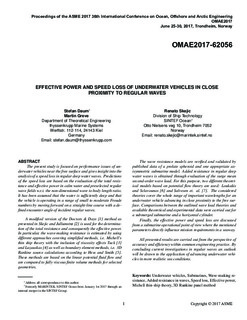| dc.contributor.author | Daum, Stefan | |
| dc.contributor.author | Greve, Martin | |
| dc.contributor.author | Skejic, Renato | |
| dc.date.accessioned | 2018-11-28T09:50:31Z | |
| dc.date.available | 2018-11-28T09:50:31Z | |
| dc.date.created | 2018-11-27T14:07:18Z | |
| dc.date.issued | 2017-06-30 | |
| dc.identifier.citation | ASME digital collection, Volume 7A: Ocean Engineering | nb_NO |
| dc.identifier.isbn | 978-0-7918-5773-1 | |
| dc.identifier.uri | http://hdl.handle.net/11250/2575233 | |
| dc.description.abstract | The present study is focused on performance issues of underwater vehicles near the free surface and gives insight into the analysis of a speed loss in regular deep water waves. Predictions of the speed loss are based on the evaluation of the total resistance and effective power in calm water and preselected regular wave fields w.r.t. the non-dimensional wave to body length ratio. It has been assumed that the water is sufficiently deep and that the vehicle is operating in a range of small to moderate Froude numbers by moving forward on a straight-line course with a defined encounter angle of incident regular waves. A modified version of the Doctors & Days [1] method as presented in Skejic and Jullumstrø [2] is used for the determination of the total resistance and consequently the effective power. In particular, the wave-making resistance is estimated by using different approaches covering simplified methods, i.e. Michell’s thin ship theory with the inclusion of viscosity effects Tuck [3] and Lazauskas [4] as well as boundary element methods, i.e. 3D Rankine source calculations according to Hess and Smith [5]. These methods are based on the linear potential fluid flow and are compared to fully viscous finite volume methods for selected geometries. The wave resistance models are verified and validated by published data of a prolate spheroid and one appropriate axisymmetric submarine model. Added resistance in regular deep water waves is obtained through evaluation of the surge mean second-order wave load. For this purpose, two different theoretical models based on potential flow theory are used: Loukakis and Sclavounos [6] and Salvesen et. al. [7]. The considered theories cover the whole range of important wavelengths for an underwater vehicle advancing in close proximity to the free surface. Comparisons between the outlined wave load theories and available theoretical and experimental data were carried out for a submerged submarine and a horizontal cylinder. Finally, the effective power and speed loss are discussed from a submarine operational point of view where the mentioned parameters directly influence mission requirements in a seaway. All presented results are carried out from the perspective of accuracy and efficiency within common engineering practice. By concluding current investigations in regular waves an outlook will be drawn to the application of advancing underwater vehicles in more realistic sea conditions. | nb_NO |
| dc.language.iso | eng | nb_NO |
| dc.publisher | ASME | nb_NO |
| dc.relation.ispartof | ASME 2017 36th International Conference on Ocean, Offshore and Arctic Engineering - Volume 7A: Ocean Engineering | |
| dc.relation.ispartofseries | ASME digital collection;OMAE2017-62056 | |
| dc.rights | Attribution-NonCommercial-NoDerivatives 4.0 Internasjonal | * |
| dc.rights.uri | http://creativecommons.org/licenses/by-nc-nd/4.0/deed.no | * |
| dc.subject | Waves | nb_NO |
| dc.subject | Underwater vehicles | nb_NO |
| dc.title | OMAE2017-62056 Effective Power and Speed Loss of Underwater Vehicles in Close Proximity to Regular Waves | nb_NO |
| dc.title.alternative | OMAE2017-62056 Effective Power and Speed Loss of Underwater Vehicles in Close Proximity to Regular Waves | nb_NO |
| dc.type | Chapter | nb_NO |
| dc.description.version | acceptedVersion | nb_NO |
| dc.rights.holder | Copyright © 2017 by ASME - postprint version the Authors. | nb_NO |
| dc.identifier.doi | 10.1115/OMAE2017-62056 | |
| dc.identifier.cristin | 1635815 | |
| cristin.unitcode | 7566,9,0,0 | |
| cristin.unitname | Skip og havkonstruksjoner | |
| cristin.ispublished | true | |
| cristin.fulltext | postprint | |
| cristin.qualitycode | 1 | |

